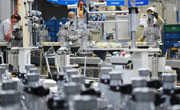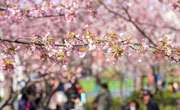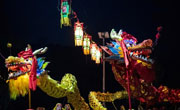Mexico City(Mexico)
Mexico City(Mexico)
[Overview] Mexico City, also known as the federal district, is the capital of Mexico. It is the country's political, economic, cultural and transportation center. Mexico City is located in a valley in the southern plateau of central Mexico. It has an altitude of 2,240 meters and covers an area of 1,525 square kilometers. The population in the downtown Mexico City is about 8.92 million, and the Mexico City metropolitan area (including satellite cities) is home to 22 million people.
[Politics] Mexico City is governed by the city council and the city government. The city council is composed of 66 members elected by citizens for a term of three years. The city council has one chairman, four vice chairmen, two secretaries-general, and two deputy secretaries-general, all elected by city councilors. The current chairman José de Jesús Martín del Campo, who is also a member of the National Regeneration Movement, took office on September 15, 2018.
Before 1997, the mayor of Mexico City was appointed by the central government. Starting from 1997, the mayor has been elected by citizens for a term of six years and cannot be re-elected. The city government is composed of the mayor's office and finance, environmental protection, education and other departments. The director of the mayor's office and the department heads are appointed by the mayor. The current mayor Claudia Sheinbaum took office on December 5, 2018.
[Economy] Mexico City is the economic, financial, and commercial center of Mexico, home to half of the country's industrial, commercial, service, and financial entities. The tertiary sector accounts for 85 percent of the city's GDP, and the city's pillar industries include finance, manufacturing, commerce, construction, and tourism.
[Culture] As the country's cultural center, Mexico City is both a metropolis full of modern vitality, and one that is home to the legacy of the Aztec civilization, one of the three ancient civilizations of the Americas, and of the Spanish culture in the colonial era. There are more than 450 museums and 40 art galleries in the city. The more than 27,000 artifacts displayed at the famous National Museum of Anthropology show the origin and development of ancient Latin American culture. The Pyramid of the Moon and the Pyramid of the Sun, located 20 kilometers northeast of Mexico City, are important cultural heritage sites in Latin America. In 1987, they were designated UNESCO World Heritage Sites. The Torre Mayor is a 55-storey building inaugurated in June 2003. Standing 225 meters in height, it had been the tallest building in Latin America until 2010. Avenue of the Insurgents (Avenida de los Insurgentes) is one of the main north-south roads running through the city, with a length of 50 kilometers. Paseo de la Reforma runs through the city from east to west and the Angel of Independence Monument stands on the center of this major thoroughfare. There are murals strongly rooted in the local culture everywhere in Mexico City which is also known as the City of Murals. The Chapultepec Forest Park, covering an area of 690 hectares, is Mexico City's largest green space. The park is also a cultural hub, housing the Museum of Anthropology, the Museum of Modern Art and the Museum of Nature. Mexico City hosted the 19th Summer Olympic Games in 1968 and the 9th FIFA World Cup in 1970.
[Education] There are 500 universities and research institutions in the city. Located in the south of the city, the National Autonomous University of Mexico is the largest and oldest university in the country. Founded in 1551, it currently has more than 300,000 students, about 35,700 teachers, and 30 research institutes, which carry out almost half of the country's research activities.
[Relations with Beijing] On October 19, 2009, Beijing and Mexico City established a sister city relationship. In recent years, the two cities have maintained close contact and engaged in fruitful cooperation.
In 2010, the Beijing-Mexico City Forum was held in Mexico City. Representatives of the two sides engaged in in-depth discussions on topics such as knowledge cities, industrial parks, economic and telecommunications development, environmental protection, historical and cultural heritage protection, rural development, culture and tourism.
In 2018, Mexico held the tenth International Friendly Cultures Fair (FICA), which featured China as the Guest of Honor. As the guest city for the event, Beijing presented a series of activities including Chinese Design, Culture, and Life Exhibition, and Beijing Culture and Creativity Week. These exhibitions, design-themed forums, business matchmaking meetings, art performances and interactive activities showed Mexican citizens the culture of contemporary China that is open, inclusive, energetic, and forward-looking.
In 2019, to celebrate the tenth anniversary of the sister city relationship between Beijing and Mexico City, the Chinese Art Exhibition co-sponsored by the People's Government of Beijing Municipality and the Mexican City Government was unveiled in Mexico City. Thirty exquisite paintings from the Beijing Research Institute of Culture and History were displayed in the historic building of the city hall.
墨西哥城(墨西哥)
【概况】墨西哥城(以下简称“墨城”)也称墨西哥联邦区,墨西哥首都,全国政治、经济、文化和交通中心。位于墨中南部高原的山谷中,海拔2240米,面积1525平方公里,市区人口约892万,含卫星城2200多万。
【政治】墨城管理机构包括市议会和市政府。市议会由66名议员组成,由市民选举产生,任期3年。市议会设议会主席1名,副主席4名、秘书长2名,副秘书长2名,均由市议员投票选举产生。现任主席何塞·德·赫苏斯·马丁·德尔坎波,国家复兴运动党,于2018年9月15日就职。
1997年以前,墨城市长由中央政府任命,1997年以后由市民选举产生,任期6年,不能连任。市政府由市长办公室和金融、环保、教育等部门组成,市长办公室主任及各部门负责人由市长任命。现任市长克劳迪娅·希恩鲍姆于2018年12月5日就职。
【经济】墨城是墨西哥经济、金融和商业中心,集中了全国一半的工业、商业、服务业和金融机构。第三产业占全市经济总量的85%,支柱产业有金融业、工业、商业、建筑业和旅游业。
【文化】墨城作为全国文化中心,即保留了美洲三大古文明之一的阿兹泰克文明遗迹和殖民时期的西班牙文化,又是一座充满现代活力的大都市。全市共有450多家博物馆,40多个艺术画廊。著名的墨西哥人类学博物馆,通过2.7万余件古文物全面展示了拉美古代文化的起源和发展。位于墨城东北部20公里的太阳月亮金字塔是拉美重要古代文明遗迹,1987年被联合国教科文组织列为世界人类文化遗产。2003年6月落成的市长塔大厦共55层,高225米,2010年以前一直是拉美地区最高建筑。城内南北干线“起义者大街”长50公里,“改革大街”横贯城市东西,街中心矗立着“独立纪念碑”。墨城随处可见具有浓郁民族风格的壁画,享有“壁画之都”的美称。查普特佩克森林公园占地690公顷,是墨城最大的生态区,人类学博物馆、现代艺术博物馆和自然博物馆均坐落于此。墨城曾举办过1968年第19届夏季奥运会和1970年第九届世界杯足球赛。
【教育】全市共有500所大学和科研机构。位于城南的墨西哥国立自治大学是全国规模最大、历史最悠久的大学,始建于1551年,在校学生超30万,教师约3.57万人,有30个研究所,集中了全国近50%的科研活动。
【两市关系】2009年10月19日,北京市与墨西哥城正式建立友好城市关系。近年来,两市交往密切,合作成果丰硕。
2010年,“北京-墨西哥城论坛”在墨西哥城召开,双方代表围绕知识城市与工业园区、经济与电信发展、环保、历史文化遗产保护、农村发展、文化和旅游等议题进行了深入交流。
2018年,墨西哥友博会创立十周年之际,中国和北京受邀分别作为特邀主宾国和主宾城市亮相该项活动。我市举办了包括“中国设计·文化·生活体验展”、北京文创周在内的系列活动,通过展览展示、设计主题论坛、北京文创产业推介洽谈会、企业对口交流、文化演出与互动等系列活动向墨西哥公众全面展现当代中国开放包容、活化传承、引领时代的文化形象。
2019年,由北京市政府、墨西哥城市政府联合主办的“庆祝北京·墨西哥城缔结友好城市关系十周年-中国艺术展”在墨西哥城盛大开幕,来自北京文史研究馆的30幅精美馆藏画作在历史悠久、古香古色的墨西哥城市政厅精彩亮相,为北京与墨西哥城建立友好城市关系10周年献上文化厚礼。
(Source: Foreign Affairs Office of Beijing Municipal Government)
[ Editor: WPY ]










More From Guangming Online
Medics from Fujian leave for Shanghai to aid in battle against COVID-19 resurgence
New int'l land-sea transport service to Indo-China Peninsula launched
Another makeshift hospital under construction in Shanghai
Tourists view tulips in Suiping County, Henan
In pics: blooming gagea flowers on grassland in Zhaosu, Xinjiang
Greek workers stage 24-hour general strike over high prices